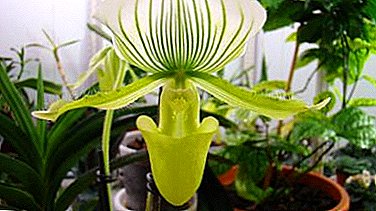
Orchid - one of the most exotic flowering domestic plants. At the same time, many gardeners say that it is the Cattleya Orchid that is the most beautiful and easiest to care for.
In the article we will talk about how to care for a plant at home, methods of reproduction, and about pests and diseases that can affect a tropical beauty.
Detailed description
Cattleya - one of the most beautiful types of orchids. Flowers have different sizes, from very small to large, and their color varies from white to dark purple. They also have a so-called “lip”, which differs in color from the flower petals. Very often this species is distinguished by its incredible aroma.
In flower shops you can buy hybrid Cattley, which are conventionally divided into spring and autumn. This division depends on the flowering time of the plant. Also, hybrid types of orchids are more adapted to homemade.
 In flower shops you can buy hybrid Cattleyas, which are conventionally divided into spring and autumn. This division depends on the flowering time of the plant. Also, hybrid types of orchids are more adapted to homemade.
In flower shops you can buy hybrid Cattleyas, which are conventionally divided into spring and autumn. This division depends on the flowering time of the plant. Also, hybrid types of orchids are more adapted to homemade.
Cattleya's homeland is South and Central America. At the beginning of the 19th century, the flower was first discovered by Europeans and quickly gained popularity. In the living environment there are about 65 species of this species. This refers to the epiphytic, because they mostly grow on the surface of trees, and sometimes they are found in mountainous areas.
From the video you can see the description of the Cattleya orchid:
History of
Cattleya is a purely tropical plant. These flowers grow in nature on rocks and trees. Their usually quite large flowers retain their freshness for a long time. In late XIX - early XX century, large-flowered drops began to grow massively in order to decorate the corsages of ballroom and evening events. This tradition is still alive, especially in the United States.
The genus was named after W. Catley, the owner of the first orchid collection in England. It was he who, in 1818, first noticed Cattleya labiata (Cattleya labiata) - an orchid that became the culprit of the "orchid fever" in the horticultural world.
Podort and their photos
To date, there are about 65 natural Cattleya species in nature, in addition, a large number of hybrid plants have been identified: both interspecific and closely related varieties. Among them can be found as miniature species, the size of which does not exceed a few centimeters, as well as plants with huge flowers and different colors. It is impossible to meet the palette of natural Cattleya, except for black and pure blue.
Of the thousands of existing species, we list only the most famous.
Bicolor
It has a bright purple lip color and red-brown petals. It grows up to 60 cm in height.

Bowring cattleya
The height of the stem can reach 70 cm in length, and usually under ambient conditions the growth does not exceed 35 cm. The pink color differs from bright yellow to reddish lips.

Cattleya forbesii
A small plant growing in Brazil. It does not grow above 20 cm. Flowers are small, green-brown with a pale pink or white lip.

Cattleya labiata
Characterized by wavy petals of pink or purple flowers with a bright purple lip with a yellow spot. The flowers are quite large - up to 20 cm in diameter.

Cattleya Varshevicha or Giant
Mountain Cattleya from Colombia. It has a large stem (can reach 25 cm in diameter) with fragrant flowers. The color is white or white-pink with a large wavy lip color purple with a yellow spot.

Home Care Tips
Soil preparation and pot
The standard Cattley substrate is pure bark without any additives. But to make the soil more fertile and durable, you can add additional components. These can be: sphagnum moss, charcoal or peat. Ideal for this kind of orchid would be a transparent pot that does not absorb light. In addition, they have an attractive and stylish appearance, because of the variety of such containers, you can choose the one that suits your taste and size.
Temperature
Cattleya is a heat-loving plant, especially during the flowering period. Most of the year, namely from spring to autumn, the necessary temperature for a flower is + 22 ... +25 degrees during the day and + 17 ... +18 degrees at night. In winter, the temperature in the room should be + 16-18 degrees. Some of the Cattleya species can tolerate temperatures even lower, but not during flowering. During flowering abundant watering is not recommended to prevent decay of the roots.
Humidity
Humidity should be above average. For Cattleya, spraying with settled water at room temperature is useful. Do this procedure better in the morning or in the evening, especially in summer.
Lighting
Like all tropical plants, orchids are very fond of bright light. Adult plants can spend several hours a day in direct sunlight, without getting burned, except for a lunch break, when the sun is especially active. Determine the need for orchids in the light can be on the condition of the leaves.
Under normal lighting, they are brilliant saturated green, when they are overheated, they become yellow-green, and when there is no sun, its leaves are repainted in a dark green color. In winter, when natural light is not enough, it is recommended to use artificial lighting, such as fluorescent lamps.
Watering
 Orchid irrigation occurs when the top layer of the substrate dries out. It is necessary to ensure that the earth does not completely dry, since it can cause a delay in flowering. Water should not be used at room temperature.
Orchid irrigation occurs when the top layer of the substrate dries out. It is necessary to ensure that the earth does not completely dry, since it can cause a delay in flowering. Water should not be used at room temperature.
The best way to water Cattley is to immerse the pot in a container of water for 5-10 minutes. In addition to this method, and especially in a stuffy room, you can use humidifiers or place pots on a container with wet claydite. When watering, it is important to take into account the growth period of the orchid, if it is a flowering period - then watering should be abundant, while at rest - moderate.
Water during irrigation should not fall on the buds and stem color, the leaves should be washed and moisturized, it is better to make special cloths for orchids.
Top dressing
Feeding for Cattleya is necessary:
- During the growth of pseudobulb.
- When the flower spike grows.
- When the orchid blossoms, fertilizers are no longer used.
Fertilizers should be special for orchids, and especially pay attention to their composition. For Cattleya, a top dressing composition with a high content of nitrogen, phosphorus and potassium is recommended.
Transfer
Kattleya does not like and does not tolerate transplantation, but it should be done once a year. One of the main causes of transplantation is soil oxidation. The most difficult thing that you can meet when the roots of a plant climbs out of a pot. This can be especially problematic if the flower has already grown and the root system has grown too much. If the orchid grows in a flexible flower pot, it should be slightly unbendled from different sides, and then carefully removed.
In case the container is heavy, you need to insert a tool, for example a knife, into the base and try to turn it into the vessel until it is easy to detach from the walls. After extraction of the orchid, it is necessary to clean the roots of the used substrate.
- To make it easier, you need to put a flower in warm water for 15-20 minutes.
- Then we clean the roots: holding them in water with one hand, at the same time we remove the woven roots to the opposite edges.
- If there are rotten or dry roots in the root system, they should be carefully trimmed with sterile tools and then disinfected with their cuts.
Before planting in a new soil, the plant must be dried. In summer it is good to use a balcony or a gazebo.
In the video you can see how to properly transplant Cattleya:
How to breed?
 The plant multiplies by dividing the bush, having at least 8-10 bulbs.
The plant multiplies by dividing the bush, having at least 8-10 bulbs.
- Before the breeding procedure, you need to prepare a new pot and support for the plant. The pot with the substrate must be placed in a container with warm water for a while.
- After that, you need to clean the roots of damaged roots and bulbs.
- Carefully divide the shrub into pegs, bearing in mind that at least one bud, several roots and at least three bulbs are required on one and the other part. Tools used in the separation of the bush should be sterilized to prevent infections.
- The last action is to place the obtained roots in different pots.
Diseases and pests
Some types of pests can affect the Katlei orchid.
Among them:
- Trify and spider mite appear in case of high dryness of the surrounding space. To prevent infection by these pests, you need to maintain the necessary moisture.
- Shchitovka can move from already infected flowers and is expressed as dark marks on the leaves. The affected areas are cleaned with insecticides.
- Mealybug and Aphid appear in dry air. Removed with insecticides or soap and alkaline solution.
- White fly appears as yellow and white spots on the leaves and leads to their death. Get rid of it by rubbing with a solution of soap.
Now you know how to care for Cattleya at home. Orchid care is important. In skillful hands, this flower will give simply unforgettable beauty and will be the pearl of the home collection of flowers.












